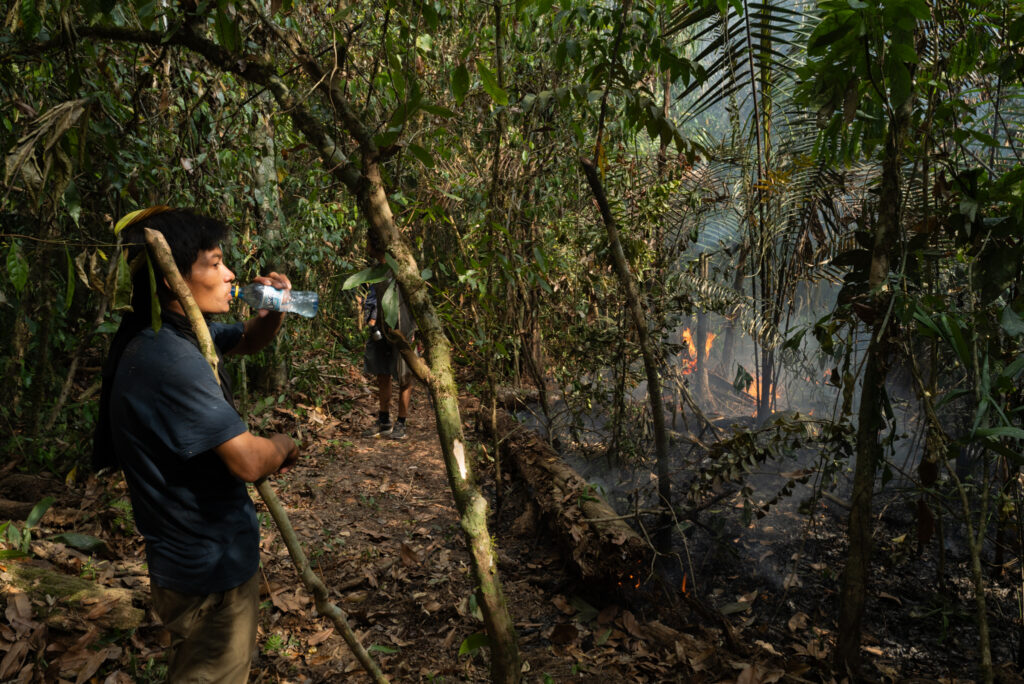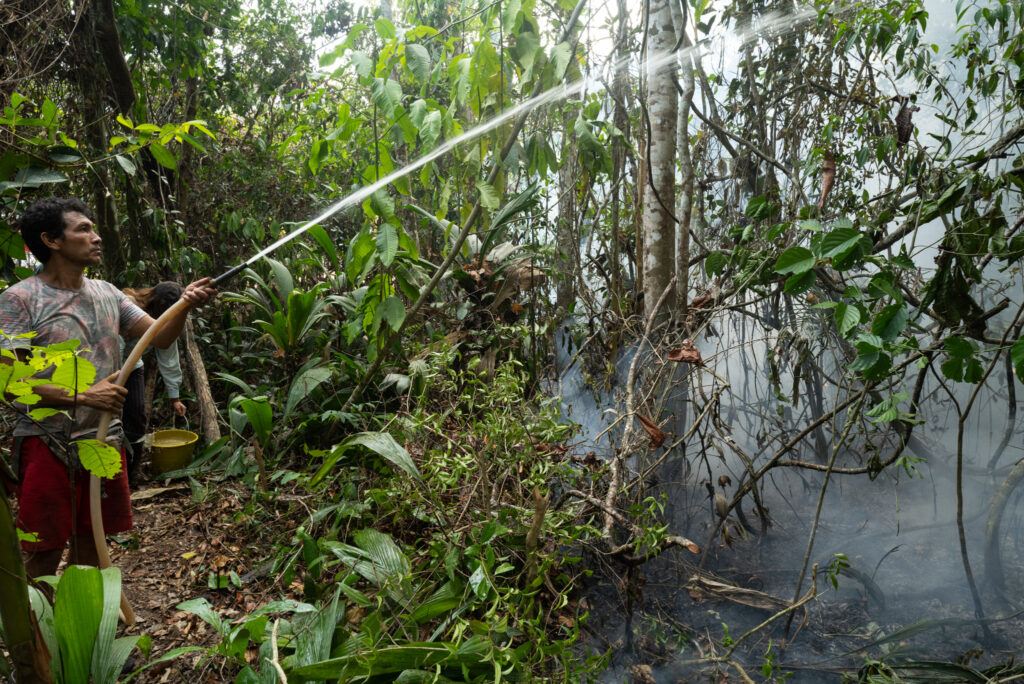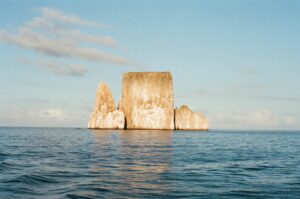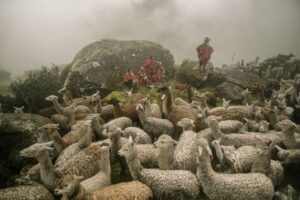Dry leaves crunched under my feet. I looked at the dead plant material layered over the forest floor and glanced ahead to a group of workers from the Yorenka Tasorentsi Institute, who were sweeping this plant litter to create what looked like a pathway through the forest. Unfortunately they were creating a firebreak, a gap in vegetation that acts as a barrier for the wildfire that was sweeping through the forest to my left. After an hour of grueling work, the workers found a log, they brushed off insects with their hands before sitting down to drink water and talk. I sat down on the end of the log, it was brittle and cracked under my weight, a sign of the many insects that occupied its core. I reached for the drink bottle attached to my camera bag. I drank water and looked to the workers as smoke blew over and around our heads, it was impossible not to breathe it in.
Ze, one of the workers, was seated next to me, and as the smoke accumulated in my lungs, I coughed. He raised his eyebrows then smiled. I realised this is not a new experience for him, he clearly has done this before, all of these men probably have. It’s a sad reality of life in the Brazilian Amazon, where fire activity is rapidly increasing. These fires are often caused by weather, but more often they are the result of the economic interests of farmers, who use fire to deforest and prepare their land for crops and pasture. Agriculture has been the most valuable sector of Brazil’s economy in recent years, so farmers are encouraged and supported in their practices as they fuel the country’s economic growth. But when farmers’ burning practices coincide with dry conditions, their fires can easily move, escaping their control, spreading across their property, and with the wind, to nearby land.

The Yorenka Tasorentsi Institute (YTI), founded by Ashaninka leader Benki Piyãko, is focused on recovering degraded land caused by illegal logging activities to create extensive cattle farms. The Institute is attempting to revert the loss of biodiversity, and the destruction of virgin forest and precious water sources, including the Jurua River, one of the most important tributaries of the Amazon River, which sustains the Amazon rain forest. Due to the focus on recovering degraded land, the YTI’s property borders farms — the land was previously owned by cattle grazers — who regularly use fire practices.
When I arrived at the YTI three weeks ago, Benki spoke of the intense drought they are currently experiencing. He encouraged me to walk through the forest to see the dying plants and trees. One day, when visiting a sacred water spring on the Institute’s land, I heard a branch fall from a nearby palm, crashing through the forest canopy onto the ground, maybe 20 metres from where I stood. I was with a friend, Hami, and I turned to him and echoed Benki’s words, “the forest needs water”. Yet the rain has not come to quench the land’s thirst, Benki says it has been over 90 days with almost no rain. Last Tuesday morning, light rain offered the forest a shower, bathing the leaves and branches without the necessary volume to satisfy the roots.
A week later, in the heat of the day, just after lunch, a group of us gathered in an outdoor seating area near the entry to Benki’s home. Benki spoke to us about the YTI’s work, and the challenges they are currently facing with the drought. He spoke about the threat of fire, knowing that September is traditionally the hottest month of the year and the wet season rains don’t truly begin until October. He then spoke of the intensity of this drought and how the Jurua River, which flanks the Institute’s land, was at a historically low level, as shallow as anyone living can remember. He then invited everyone on a field trip, in two boats, to experience the truth in his words. We travelled less than a kilometre up the River, we had to get out twice to push the boats when the water was too low. Eventually when there was not enough water for us to move any further, we got out, stepping into the River, which reached our shins or ankles, depending on our height. Despite this sad reality, Benki encouraged everyone to bathe in the River and enjoy the power and beauty of the water.
This drought has intensified with the return of the El Niño weather system, which involves the weakening of easterly trade winds and the subsequent movement of warm water from the western Pacific to the western coast of South America. It is the warm phase of the El Niño–Southern Oscillation (ENSO), which is countered by a cool phase, La Niña. The United States of America’s National Oceanic and Atmospheric Administration, through its Climate Prediction Center, released a report in early June heralding that El Niño conditions were again present in the world.

During the past two major El Niño events (from 2014 to 2016, and 1997 to 1998), the Amazon rain forest experienced significantly severe droughts. Research conducted by Dr Amy Bennett, a Research Fellow in the Faculty of Environment at the University of Leeds, found that in the 2014 to 2016 El Niño event, the Amazon rain forest was unable to function as a carbon sink due to an increase in the death of trees. It reminds me of Benki’s words, how the trees are dying, which in turn reminds me of a speech he offered in the initial days of this visit. A group of us were sitting in the forest: Benki’s family, workers from the Institute and guests, like me, Occidentals, who Benki calls “my friends from all over the world”. We shared the afternoon together, listening and learning with the plants, as we tuned into the natural consciousness that surrounded us.
It’s easy to think the forest is not aware, science has been arguing this for years. Growing evidence acknowledges the conscious activity of natural ecosystems, and how being with nature can improve physical and mental health. This was the focus of Benki’s speech, which offered his understanding of the qualities of the forest.

“We are alive, we breathe air, air is medicine. Who breathes poison? Nobody breathes poison, you would die. When we go into the forest, we breathe fresh air, because the forest purifies everything. The Earth gives everything to us. It gives us trees that are able to give us fruit… If you eat the fruit of a native tree, it’s pure medicine. If you drink the tea from the bark of a native tree, it’s pure medicine. If you wet the earth, and take a bath in the clay, it’s pure medicine. Everything is medicine here.
“The science world today discovers everything there is in the forest, all of the molecules of all of the plants, that is important, yet everyone wants to be the owner of the discovery of these plants, yet they are not the owner of anything. This thinking has created and spread a sickness in the world.
“This is why we need to take care of the natural medicines, because they can heal, man can heal, the forest can heal. We need to take care of this diversity. Do you think the animals of the forest need a vaccine? They don’t, because they know all of the medicines of the forest, they know what to eat to be able to heal the illnesses inside their bodies. Do we know more than the animals, are we the teachers teaching the animals how to live with this knowledge? No. They are born like that, like we are born like that, but they take much better care than the man. And that’s what we say worldwide, if we don’t take care of the water, of the Earth, we will come to the point where there will be nothing left.”
These words were enhanced by the setting of Benki’s talk, the forest that he was speaking with, and I recalled his words as I followed the workers carving firebreaks through the forest with machetes and rakes. We had arrived at an opening, and I followed them into a clearing and I saw the devastation of the fire we were meeting: the ground before us was covered in grey and white ash, most of the tree trunks were now black, half their previous size, and the green leaves of this part of the forest had vanished in flames the previous night. The opening was maybe 850 metres long and 100 metres wide, and walking through the dead trees and charred remains of the plants that once covered the forest floor, offered space to see the group of workers and volunteers who had gathered to put out the fires that had spread over the Yorenka Tasorentsi Institute’s land. Everyone’s face reflected the devastation they were feeling, trying to comprehend the landscape we were witnessing, knowing just 24 hours before it was beautiful lush forest filled with the conscious awareness of the plants, trees, animals and insects who co-created this ecosystem. We all felt the grief of the life that we had lost.

With our heads bowed, we made our way back into the forest that remained, searching for the source of the smoke that was entering our lungs, finding small and big fires that we tried to put out with rakes and shovels. When we thought we had contained a small section of fire, it would spark again and burn with speed, and we would rush to contain it. We split into small groups to focus on the different fires, each group armed with machetes and rakes. I regularly thought, surely there is a better way to fight this fire. One of the other volunteers told me that Benki had called the Mayor of the local town Marechal Thaumaturgo, Valdélio Furtado, for support. “They have no fire fighting service nor fire fighting equipment to offer, so Valdélio came with his colleagues and friends.”
He was pointing to the man that was leading our group through the forest, wearing a peach coloured polo shirt and a white cap while carrying a long stick to help clear through the plants and vines. He held up a large vine for the group to pass under, I smiled at him to show gratitude, he smiled back and nodded, and as I went to grasp a nearby tree to balance as I stepped over a log on the ground, he pointed with his stick to stop me. I looked at him, he pointed to the tree and then shook his head. He spoke to me in Portuguese and my friend Tommaso translated, “he said not to touch that”, I asked why, “I’m not sure, but it won’t be good for your skin”. I needed something to hold onto, so I grasped a nearby branch that was part of a different plant. It shook with my weight. Two ants fell from higher branches onto the back of my hand, I hadn’t noticed until I received my first bite, and a deep pain moved along my fingertips and up towards my shoulder. It was followed by a second bite, so I quickly brushed the ants from my hand. I felt to make a noise to communicate my pain, but I realised fighting a fire deep in the rain forest means being exposed to insects my body isn’t used to.
I was pulled from my pain by a sound in the distance: a tractor and falling trees. I followed the group as we trudged ahead and the sound became louder. Soon I could see a yellow and black New Holland bulldozer, operated by Chagas, one of the key workers at the YTI. He was creating a path into the forest that would support the next phase of the fire fight. Benki had reflected on the work of the morning, he felt we hadn’t stopped the fires we had attempted to, in some situations we helped to spread them, so we needed a new approach. Chagas’ path would allow us to carry water with buckets and large plastic bottles. We would still sweep up the organic matter that covered the forest floor to create firebreaks, but we would also complement this with water, dampening the Earth to slow the fire’s path, and when we could, using water to extinguish the flames.
In this moment, a pickup truck arrived and the crew inside offered us lunch: a caldo (a stew) kindly cooked by Nayana, another key member of the YTI team. Everyone gathered to regenerate, and then it was back to work, now with the aid of water. When it got dark, a group of six people, including Benki, tried to contain a fire that had unexpectedly erupted out of control, spreading throughout the forest. They worked all night, combatting the sparks and flames that were spreading through the dry plant material on the forest floor. They returned to the community in the morning to pick up those who were ready to support, directing them to this new front. Chagas had also been working hard, fixing an 80 year old truck to ensure the day’s activities were better resourced. The truck’s tray was fitted with two large containers for water, which would be pumped into an assortment of connected hoses. The fire the team were trying to contain throughout the night had moved towards one of the roads that helped navigate the Institute’s 1100 hectares. This location assisted our efforts, as it meant the truck could remain on the road and a new path didn’t need to be created. We could also access a nearby fish pond, further up the road, when we ran out of water.

I had woken that morning with a swollen right hand, a result of the ant bites from the previous day, and a large wound on my right knee. Everyone was visibly affected by this experience, if not through wounds like my own, then a furrowed brow reflected their emotions. Yet the team’s morale was high, the care for one another was palpable, a sense of community was clearly our strongest resource. This was emphasised when we began using the pump and hose. The containers couldn’t hold enough water for sustained use — a larger container was eventually sought — the pump needed to be fixed on two occasions, and the connecting hoses often sprayed water. Again I found myself thinking, surely there is a better way to fight this fire, appreciating the lack of resources at the YTI, as well as the municipality of Marechal Thaumaturgo, to face this situation.
The past two Presidents of the Federative Republic of Brazil, Michel Temer and Jair Bolsonaro, liberally cut funding to the Brazilian Institute of Environment and Renewable Natural Resources (IBAMA). Among its directives, IBAMA is focused on protecting the forest from loggers, farming and grazing, as well as other activities, like fire, that threaten the Amazon rain forest. In 2017 Temer cut IBAMA’s budget by around 40%, in 2019 Bolsonaro removed 24%, and he removed a further 24% in 2021. These cuts led to IBAMA’s removal of approximately 1400 people who worked at the National Center for Prevention and Fight against Forest Fires (Prevfogo) in 2020, citing an “exhaustion of resources”.
In this political landscape, in an economy that subsidises the destruction of the rain forest, I understand why an Indigenous-led organisation like the YTI, in the remote state of Acre, in the even more remote municipality of Marechal Thaumaturgo, lack the resources to fight a wildfire. It underlines why the International Indigenous Peoples Forum on Climate Change (IIPFCC) have been so focused on securing funds at the United Nations’ climate conferences to build resilience and adapt to a changing climate. Yet this movement took many years to gain the necessary commitment from governments, and frontline communities now need to wade through a bureaucratic system of policies and guidelines to receive money, further delaying the support they need. It’s with urgency that the YTI, along with their partners the Boa Foundation and Little Treehouse, have been fundraising — to purchase a truck with a water tank and firehoses, and backpacks to carry and disperse water — to combat the conditions of this deepening drought and the possibility of more fire. This equipment will also support the thirsty forest throughout the drought, as well as the Institute’s ongoing planting efforts.

As I write these words, after four days, the fire still burns. Last night, we thought it was under control, allowing Benki time to rest, to sit with the group under the stars, to watch the moon rise, and offer his reflections to us all.
“For us, in our lives, we see the Earth not just as a place where we walk, but also as a Mother. It’s Her that is supporting this living universe, and today we see everything the Earth has been giving us for millions of years, and this change that is happening now will affect all of our lives. We cannot think about what will happen in the future, we need to think about the present moment, because what we are planting here in the present moment will define our future…
“We have to see all of the plants as brothers and sisters of our life, because it’s from them, and our Mother, that we breathe, that we eat. We are all connecting to the same source… And this heat that is happening is our responsibility, it is the responsibility of every government, every person of this Earth, and if no one takes care of it, we will pay a high price that no one deserves…
“We lost more trees in four days than what we planted in the first five years of the Institute, as well as all of the plants and animals that also died there. Since I was a kid, I have been planting the forest to save the biodiversity, and now I am experiencing this shock. We need the consciousness to understand what we are doing with our lives. This has been very strong for me, very hard…
“These past two days, it rained over all the surrounding areas, but not here, in this place. There was a very strong wind, but it didn’t rain. But it was good, all of the other fires in the area are now out. And we, like hummingbirds, carried water to put out our fire. And all of you who came and helped us in this difficult moment, it created an opportunity for us all to see this reality and think about what we are going to do from now on.”
What will we do? For us here at the Yorenka Tasorentsi Institute, the fire still burns, and we continue on together, protecting our Mother, our nature, our world.
Anton Rivette is a writer and photographer. He leads storytelling at eco-nnect.
You might also like: Indigenous Sovereignty: the contention of Marco Temporal













